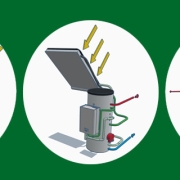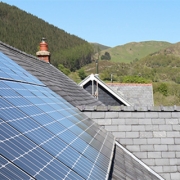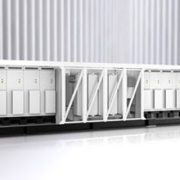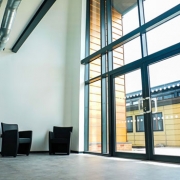Capable of offsetting typically around 30% of the energy demands for water heating, solar thermal systems are ideal for organisations that rely on large amounts of domestic hot water (DHW).
For the existing buildings, 80% of which are still expected to be in use by 2050, the application of solar thermal pre-heat is a well-established means of reducing demands on prevalent gas-fired water heating helping to offset operational costs but actively cutting carbon emissions from the buildings. Commercial new builds or refurbishments, however, are either mandated or opting to shift to direct electricity are finding that move comes with a new financial burden as electricity remains substantially more expensive to operate than gas – currently by a factor of 3.8. Undisputed carbon and cost savings mean we are seeing a definite upswing in interest for new solar thermal systems with a ten-year return on investment being very achievable.
A correctly designed and sized system will consider the daily usage and peak demands. Its aim is to serve all peaks from storage, with the size of the peak determining the size of pre-heat. The recovery time for peaks is what ultimately determines the number of solar collectors a building requires. The design process also sizes usage with available space. A south-facing and unobstructed roof with an inclination of 30° from the horizontal is optimal, though by no means essential as modern solar collectors can be installed in a variety of permutations. Unsurprisingly, solar thermal collectors do suffer if the building is significantly shaded, in which case a commercial air source heat pump may be a preferred option to produce low-carbon heat.
Modular, high-performance flat plate collectors can be situated on or integrated into flat or sloped roofs, as well as mounted on a building’s façade. By far the most efficient way to heat water with solar energy, flat plate collectors offer a smaller footprint compared to equivalent solar photovoltaics (PV) for DHW. A typical 4 kW PV system requires approximately 16 panels covering 25m² of roof to match just three flat plate collectors covering just 6.6m² roof area. This makes solar thermal a prime choice when roof or facade space is limited.
Adveco collectors feature a copper meander absorber through which passes the solar fluid (glycol). The fluid transfers solar energy as heat to the system’s water via an indirect cylinder. To correctly manage solar fluid drain back technology should be applied to protect the fluid from overheating. This can ‘cook’ the fluid to a tar-like consistency causing permanent damage to the collector. As the name implies the solar fluid drains from the collector to a reservoir when not in use. Flat plate collectors with an integrated drain back module offer a more cost-effective (as there is no requirement for large solar storage) and more efficient (as there is no call to dump unused heat) approach. The technology has proven itself in the field with fluid changes required perhaps once in eight years, rather than the expected three.
For new build properties with electrical connection, the gas water heater is replaced with an electric boiler and cylinder to supply the afterheat which raises system temperatures to a necessary 60°C. This hybrid approach maximises the solar thermal input, typically offsetting 30% of the electrical demand, although it could be more depending on location. Adveco has simplified this hybrid approach by integrating a packaged FUSION E electric water heating system. This also gives the option of adding an electric immersion to the system as a backup for enhanced resiliency when assured water heating is a business-critical service. The all-electric solar thermal approach further reduces carbon associated with grid electric systems and aids in lowering operating costs.
This hybrid approach can be further extended with the inclusion of air source heat pumps to provide the initial pre-heat for the system. Operating at lower temperatures with the cold feed maximises the efficiency of the heat pump, reducing electrical operating costs and raising working flow temperatures from 10°C to 40°C. This is not hot enough for commercial applications, so the pre-heated water is then passed to the mid-solar thermal system. Essentially free to operate, the solar thermal system boosts the working flow temperatures from 40°C to at least 50°C. Although not operating at maximum potential, there is enough advantage gained from solar thermal to warrant the additional system complexity and capital investment. During summer months it is possible for the solar thermal system to deliver the necessary 60°C working flow for safe provision of commercial hot water. But to ensure safe, consistent, and necessary high operational temperatures, the water is passed to the FUSION electric water heater. Here final consistent water temperatures of up to 65°C are assured year round.
To date, Adveco has designed and supports more than 800 live solar thermal systems across the UK and such hybrid approaches are unavoidable if commercial projects seek a sensible, practical, and cost-effective path to low-carbon hot water.
VISIT THE ADVECO WEBSITE
![]()






